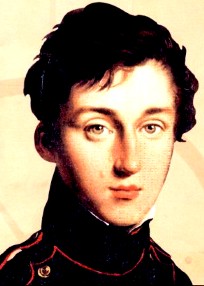Nicolas Léonard Sadi Carnot (1796–1832)
Sadi Carnot was the eldest son of Lazare Carnot and he was born in the Palais
du Petit-Luxembourg. His younger brother was Hippolyte Carnot. At the time of
Sadi's birth, his father was a member of the Directory, the French Revolutionary
government which lasted four years from November 1795 to November 1799. Sadi
was given named after a medieval Persian poet and philosopher called Sadi of
Shiraz. Sadi Carnot was born at a time of unrest and political turmoil in France
and, due the position of his father, whose fortunes changed dramatically many
times, he was brought up in a totally unstable environment of interacting politics
and science. His father was appointed to the high office of Napoleon's minister
of war in 1799. Lazare Carnot resigned in 1807 and devoted himself to the education
of his two sons.
His famous work on the motive power of heat (Réflexions sur la puissance
motrice du feu, 1824 is concerned with the relation between heat and mechanical
energy. Carnot devised an ideal engine in which a gas is allowed to expand to
do work, absorbing heat in the process, and is expanded again without transfer
of heat but with a temperature drop. The gas is then compressed, heat being
given off, and finally it is returned to its original condition by another compression,
accompanied by a rise in temperature. This series of operations, known as Carnot's
cycle, shows that even under ideal conditions a heat engine cannot convert into
mechanical energy all the heat energy supplied to it; some of the heat energy
must be rejected. This is an illustration of the second law of thermodynamics.
Carnot's work anticipated that of Joule, Kelvin, and others.
Under his father's tuition, Sadi Carnot showed great promise and was sent to the Lycée Charlemagne in Paris to prepare him for the examinations to the Ecole Polytechnique in Paris. In 1812, at age 16 the minimum age possible, Carnot entered the Ecole Polytechnique where Poisson Ampére and Arago were among his teachers. Chasles was in the same class as Carnot and their friendship lasted throughout Carnot's life. Carnot graduated from the Ecole Polytechnique in 1814 but, before he graduated, Carnot and other students from the Ecole Polytechnique fought unsuccessfully with Napoleon to defend Vincennes.
In October 1815 after the defeat of Napoleon, Carnot's father was exiled and he went to Germany never to return to France. It is probable that a military career was not the easiest one for Carnot with his father in exile. Carnot was moved from place to place, given jobs of inspecting fortifications, drawing up plans and writing reports. However, it seems that he was not well treated and his recommendations were ignored. Unhappy at his lack of promotion and the refusal to give him a job which allowed him to make use of his training, in 1819, he sat and passed the examinations to join the recently formed General Staff Corps in Paris. Almost immediately he took leave on half pay, living in Paris in his father's former apartment, but he remained on call for army duty.
Carnot began to attend courses at various institutions in Paris, including the Sorbonne and the Collège de France. At this time he became interested in industrial problems and, in particular, began to study the theory of gases. The first of Carnot's major works was a paper which he wrote in 1822-23. This paper attempted to find a mathematical expression for the work produced by one kilogram of steam. Carnot continued with his research after the publication of his book and although nothing of this was published, notes that Carnot made as his ideas developed have survived. In 1827, however, the General Staff Corps in Paris was reorganised and he was recalled to full time duties.
Following his father's political views, Carnot was strongly republican
so he was pleased with the direction France seemed to be going with the July
1830 Revolution. Around this time he became interested in public life, in particular
he was interested in improving public education. He was suggested for a government
position, but he declined and, after the monarchy was restored, he returned
to his scientific work. In June 1832 he took ill and had not fully regained
his strength when the cholera epidemic of 1832 hit Paris. Although only 36 years
of age, he died within a day of contracting cholera.
That Carnot's important book Réflexions sur la puissance motrice du feu et sur les machines propres à développer cette puissance should have been neglected at the time of its publication is certainly not because it went unnoticed. It was published on 12 June 1824 and on 26 July of that year Pierre Girard gave a long review of it to the Académie des Sciences in Paris. 'Pierre Girard's review was a very positive one and was published in the Revue encyclopédique. Perhaps the problem with the review was that although it stated the theorems and the conclusions of Carnot's work fully, it did not comment on the highly original reasoning which Carnot had employed to achieve his results. (reference)

Connect with us
Contact us today